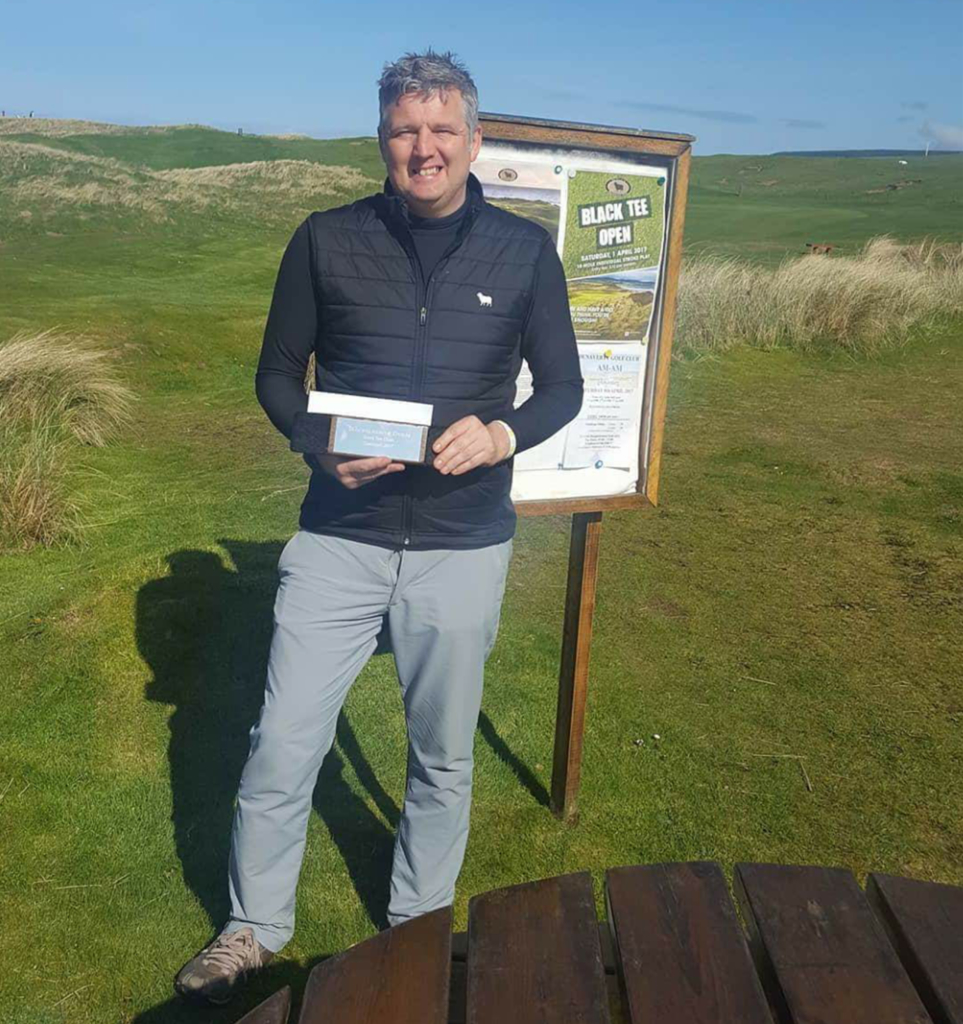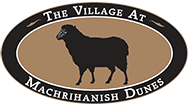57 golfers made the brave decision to play Machrihanish Dunes from the black tees the first weekend in April. Although the benign conditions helped players to negotiate the extra-long golf course, trying to reach the fairways from the back sticks and then play approach shots to some extremely testing pin positions wore many of the competitors down.
Davey Lamont eventually triumphed, despite returning to the Golf House with his own tales of woe. His score of 77 was one better than Dean Ratcliff could manage, although Dean was understandably pleased with his effort off a handicap of 6. Stuart Cameron finished 3rd and scooped the last of the scratch prizes.

Kenneth Imrie won the handicap prize with a nett 76, while Eleanor Black valiantly battled the course to win the ladies prize with a scratch 93.

Although the competitors unanimously agreed that it would be a welcome relief to get back to playing from the whites, the Black Tee Open was a fun event with which to start the Machrihanish Dunes competition calendar. You can see a full list of our golf tournaments here. Feel free to contact Lorna at the Golf House (0158 681 0058) any time to sign up for any of them.

Topdressing. Why do we do it?
Regular readers of these updates will have heard all about this subject before, but if you are new to this blog and have watched us spread sand all over the greens while wondering why we chose to do that just when the greens were putting well –well, here is the definitive list of the five benefits of topdressing.
1)Topdressing allows us to build up a layer of perfect rootzone material on the surface of our greens. The more topdressing we add, the deeper this layer will get and the deeper our root systems will become as a result. Golf greens are not always constructed from ideal materials, but adding lighter topdressing material to a heavy soil green, or a more organically-rich material to a green deficient in humus, is a proven method of improving the grass quality, root depth, and playing characteristics or every golf green. This work has been successfully undertaken since the days of Old Tom Morris. It is claimed that he invented the process. However, I can’t help but wonder whether some of the many things that Old Tom claimed to be of his own invention weren’t plagiarised from somewhere else! Oh well, topdressing works, so kudos to him for bringing it to the attention of the mainstream!!
2)Topdressing dilutes the organic matter that is deposited on the surface of the green and allows oxygen to circulate better just under the surface. This reduces disease incidence and aids the health of beneficial mycorrhizal bacteria – which need oxygen in order to live and go about their business of munching through the organic matter and turning it into plant food. This organic matter comes from a variety of sources – grass clippings that fall out of a mower box, decaying leaves from unhealthy plants, dead worms and leatherjackets; it can all be converted to useable forms of energy but only if the bacteria that can do this job are present in sufficient numbers. If airflow is blocked by surface organic matter then oxygen will not be able to enter the rootzone – and these bacterial colonies will be poisoned to the point of extinction by the carbon and sulphurous gasses that will build up. Once this happens, the plant will have to rely on whatever expensive spoon-feeding we decide to give to it via our sprayer, and fungal diseases will spread with alarming regularity, as the bacteria that would normally serve as their natural predators are not around to keep up the good fight.
3)When topdressing is brushed into the green it fills in and builds up small undulations as it is cleared off high spots and deposited wherever the brush has an opportunity to leave it. The smoother the surface of the green is, the less resistance will be imparted on a golf ball, resulting in the ball rolling farther before coming to rest, This means we can produce a “faster” surface without resorting to cutting greens shorter, which removes leaf area and reduces the plant’s ability to photosynthesize. When we topdress regularly, we can give you the surfaces you want to play on and keep the grass in optimal health.
4)Having a good amount of topdressing in the upper profile allows us to present a firm, fast-playing surface. Mowers and greens irons can level out a soft, spongy surface, but that effect will be short lived once players and course staff start walking over the newly prepared green, as the soft surface will be easily indented. A green that has a carefully controlled percentage of organic matter will be firmer and therefore less susceptible to this disruption from foot traffic. Think of the beach – if you walk on the soft, dry sand above the high tide line and then try to roll a football along it the ball will bounce and bobble and soon come to rest, whereas if you walk along the firm sand that has recently been washed by the high tide you will cause minimum disruption and your football will run and run (usually into the sea and then straight out towards Northern Ireland in my experience!). Topdressing on a regular basis allows us to present a surface which is very reminiscent of the hard section of sand just above the high tide line. A firm surface is advantageous to us as greenkeepers as well as to you as players; not only does it provide a better surface to putt on but it is also resistant to damage.

5)Topdressing feeds the grass. Well, the topdressing we use does anyway. Many courses use pure sand for topdressing, as they rightly consider that their levels of organic matter are so high that they wish to dilute it as much as possible when they topdress. Our rootzones, on the other hand, are still very sandy and are deficient in certain nutrients. We take this opportunity to add a portion of good quality soil to our topdressing. This will add nutrients and create an ideal living environment for the bacteria that we need to have present in our rootzone to break down thatch, and convert the nutrients we apply into available and useable forms of plant food. We will, of course, monitor organic levels to ensure that our rootzones do not become overly rich. Currently though, we are in the extremely fortunate position to be able to manipulate these levels to suit our exact needs.
What’s up next?
Our full focus is now on the upcoming Campbeltown Open which is planned for the 24th-25th June. The Campbeltown Open is our weekend festival of golf; including the main Campbeltown Open Tournament, the Colin Chrystie Cup, the Ladies’ Campbeltown Open, and of course, our renowned Junior Drive, Pitch and Putt Competition. Although, we recognise that the Campbeltown Open is a serious event, we and our sponsors wish to promote a welcoming atmosphere over a whole weekend. That will include prize-givings, evening entertainment, and a Sunday barbeque. If you wish to enter any of the competitions during the Campbeltown Open weekend, or you would like any further information, give Lorna a phone on 0158 681 0058. It is going to be a lot of fun, so make sure you get involved!

